Business Law Case Study: Exploring Negligence and Liability Scenarios
VerifiedAdded on 2023/06/09
|5
|1314
|458
Case Study
AI Summary
This business law case study analyzes a scenario involving Sam Speed, who runs an aircraft refueling service and whose negligence leads to fuel contamination. The analysis applies tort law principles, specifically the duty of care, breach of duty, and damages, to determine Sam's liability in ...
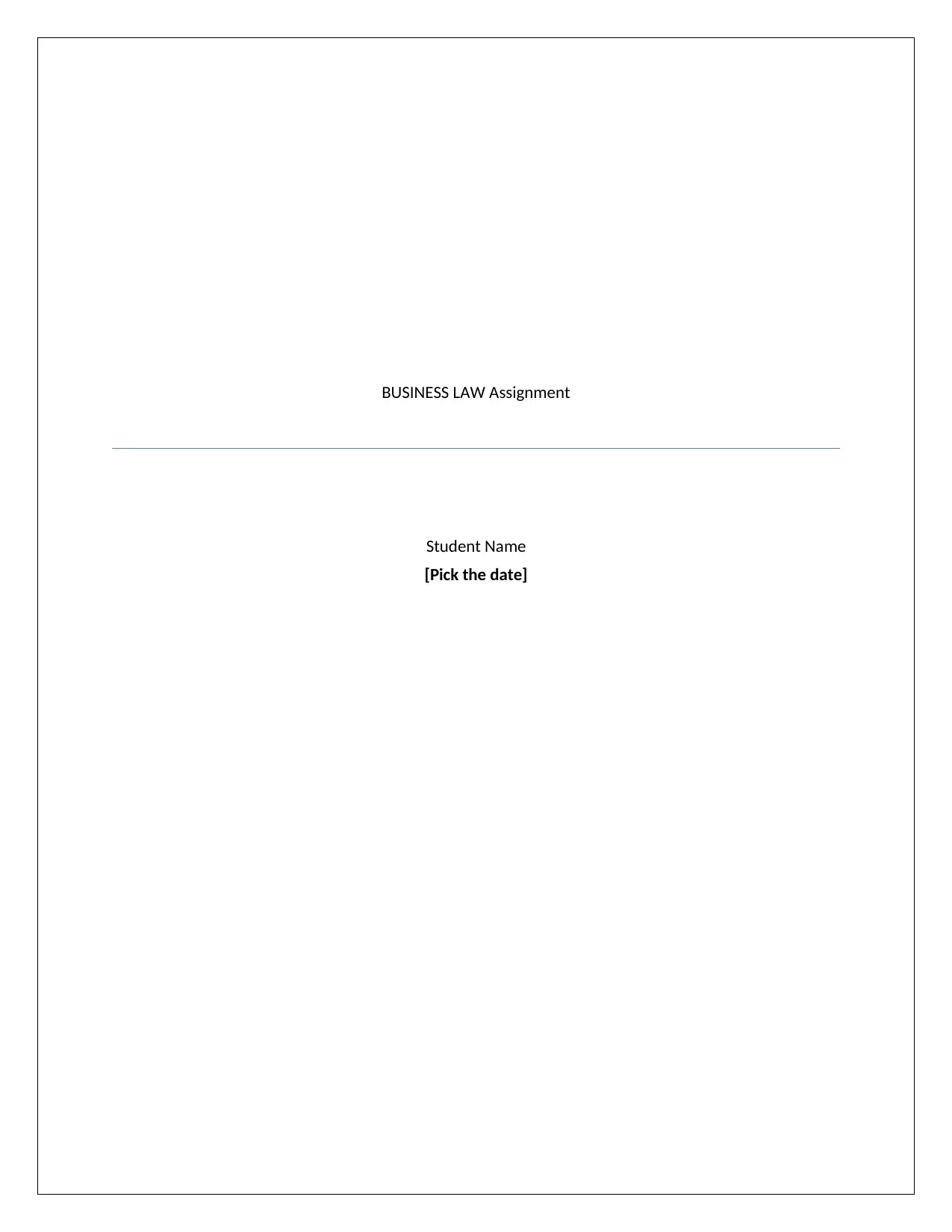
BUSINESS LAW Assignment
Student Name
[Pick the date]
Student Name
[Pick the date]
Paraphrase This Document
Need a fresh take? Get an instant paraphrase of this document with our AI Paraphraser
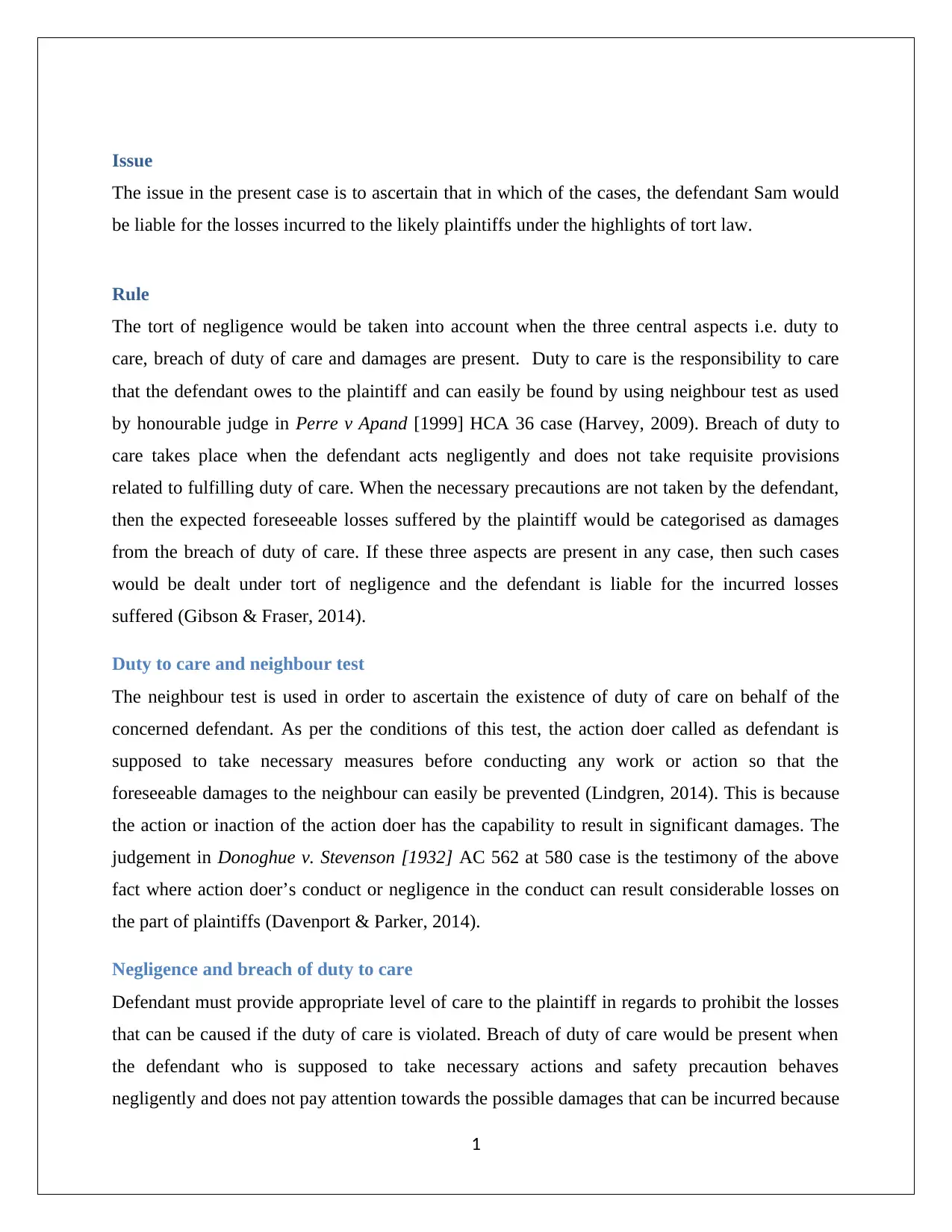
Issue
The issue in the present case is to ascertain that in which of the cases, the defendant Sam would
be liable for the losses incurred to the likely plaintiffs under the highlights of tort law.
Rule
The tort of negligence would be taken into account when the three central aspects i.e. duty to
care, breach of duty of care and damages are present. Duty to care is the responsibility to care
that the defendant owes to the plaintiff and can easily be found by using neighbour test as used
by honourable judge in Perre v Apand [1999] HCA 36 case (Harvey, 2009). Breach of duty to
care takes place when the defendant acts negligently and does not take requisite provisions
related to fulfilling duty of care. When the necessary precautions are not taken by the defendant,
then the expected foreseeable losses suffered by the plaintiff would be categorised as damages
from the breach of duty of care. If these three aspects are present in any case, then such cases
would be dealt under tort of negligence and the defendant is liable for the incurred losses
suffered (Gibson & Fraser, 2014).
Duty to care and neighbour test
The neighbour test is used in order to ascertain the existence of duty of care on behalf of the
concerned defendant. As per the conditions of this test, the action doer called as defendant is
supposed to take necessary measures before conducting any work or action so that the
foreseeable damages to the neighbour can easily be prevented (Lindgren, 2014). This is because
the action or inaction of the action doer has the capability to result in significant damages. The
judgement in Donoghue v. Stevenson [1932] AC 562 at 580 case is the testimony of the above
fact where action doer’s conduct or negligence in the conduct can result considerable losses on
the part of plaintiffs (Davenport & Parker, 2014).
Negligence and breach of duty to care
Defendant must provide appropriate level of care to the plaintiff in regards to prohibit the losses
that can be caused if the duty of care is violated. Breach of duty of care would be present when
the defendant who is supposed to take necessary actions and safety precaution behaves
negligently and does not pay attention towards the possible damages that can be incurred because
1
The issue in the present case is to ascertain that in which of the cases, the defendant Sam would
be liable for the losses incurred to the likely plaintiffs under the highlights of tort law.
Rule
The tort of negligence would be taken into account when the three central aspects i.e. duty to
care, breach of duty of care and damages are present. Duty to care is the responsibility to care
that the defendant owes to the plaintiff and can easily be found by using neighbour test as used
by honourable judge in Perre v Apand [1999] HCA 36 case (Harvey, 2009). Breach of duty to
care takes place when the defendant acts negligently and does not take requisite provisions
related to fulfilling duty of care. When the necessary precautions are not taken by the defendant,
then the expected foreseeable losses suffered by the plaintiff would be categorised as damages
from the breach of duty of care. If these three aspects are present in any case, then such cases
would be dealt under tort of negligence and the defendant is liable for the incurred losses
suffered (Gibson & Fraser, 2014).
Duty to care and neighbour test
The neighbour test is used in order to ascertain the existence of duty of care on behalf of the
concerned defendant. As per the conditions of this test, the action doer called as defendant is
supposed to take necessary measures before conducting any work or action so that the
foreseeable damages to the neighbour can easily be prevented (Lindgren, 2014). This is because
the action or inaction of the action doer has the capability to result in significant damages. The
judgement in Donoghue v. Stevenson [1932] AC 562 at 580 case is the testimony of the above
fact where action doer’s conduct or negligence in the conduct can result considerable losses on
the part of plaintiffs (Davenport & Parker, 2014).
Negligence and breach of duty to care
Defendant must provide appropriate level of care to the plaintiff in regards to prohibit the losses
that can be caused if the duty of care is violated. Breach of duty of care would be present when
the defendant who is supposed to take necessary actions and safety precaution behaves
negligently and does not pay attention towards the possible damages that can be incurred because
1
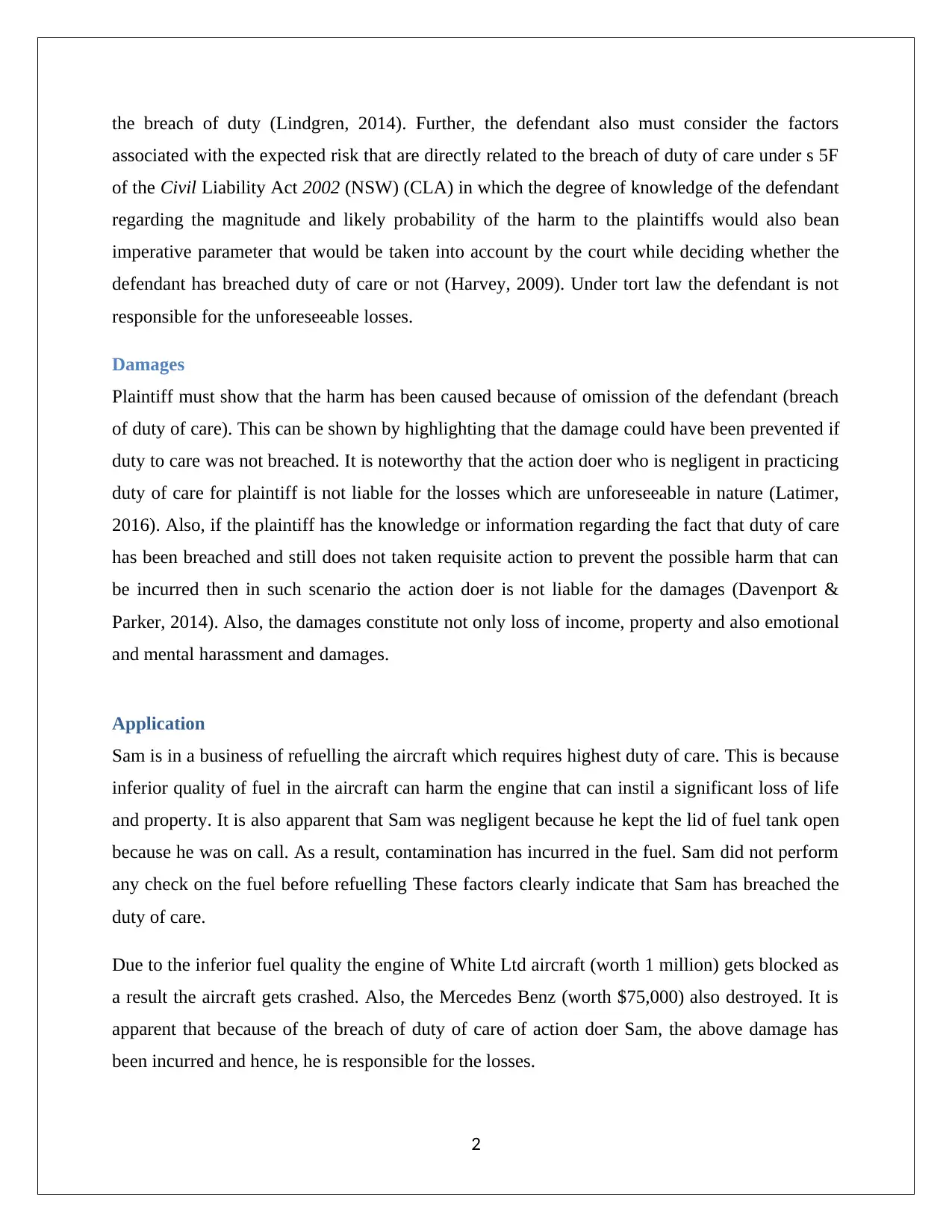
the breach of duty (Lindgren, 2014). Further, the defendant also must consider the factors
associated with the expected risk that are directly related to the breach of duty of care under s 5F
of the Civil Liability Act 2002 (NSW) (CLA) in which the degree of knowledge of the defendant
regarding the magnitude and likely probability of the harm to the plaintiffs would also bean
imperative parameter that would be taken into account by the court while deciding whether the
defendant has breached duty of care or not (Harvey, 2009). Under tort law the defendant is not
responsible for the unforeseeable losses.
Damages
Plaintiff must show that the harm has been caused because of omission of the defendant (breach
of duty of care). This can be shown by highlighting that the damage could have been prevented if
duty to care was not breached. It is noteworthy that the action doer who is negligent in practicing
duty of care for plaintiff is not liable for the losses which are unforeseeable in nature (Latimer,
2016). Also, if the plaintiff has the knowledge or information regarding the fact that duty of care
has been breached and still does not taken requisite action to prevent the possible harm that can
be incurred then in such scenario the action doer is not liable for the damages (Davenport &
Parker, 2014). Also, the damages constitute not only loss of income, property and also emotional
and mental harassment and damages.
Application
Sam is in a business of refuelling the aircraft which requires highest duty of care. This is because
inferior quality of fuel in the aircraft can harm the engine that can instil a significant loss of life
and property. It is also apparent that Sam was negligent because he kept the lid of fuel tank open
because he was on call. As a result, contamination has incurred in the fuel. Sam did not perform
any check on the fuel before refuelling These factors clearly indicate that Sam has breached the
duty of care.
Due to the inferior fuel quality the engine of White Ltd aircraft (worth 1 million) gets blocked as
a result the aircraft gets crashed. Also, the Mercedes Benz (worth $75,000) also destroyed. It is
apparent that because of the breach of duty of care of action doer Sam, the above damage has
been incurred and hence, he is responsible for the losses.
2
associated with the expected risk that are directly related to the breach of duty of care under s 5F
of the Civil Liability Act 2002 (NSW) (CLA) in which the degree of knowledge of the defendant
regarding the magnitude and likely probability of the harm to the plaintiffs would also bean
imperative parameter that would be taken into account by the court while deciding whether the
defendant has breached duty of care or not (Harvey, 2009). Under tort law the defendant is not
responsible for the unforeseeable losses.
Damages
Plaintiff must show that the harm has been caused because of omission of the defendant (breach
of duty of care). This can be shown by highlighting that the damage could have been prevented if
duty to care was not breached. It is noteworthy that the action doer who is negligent in practicing
duty of care for plaintiff is not liable for the losses which are unforeseeable in nature (Latimer,
2016). Also, if the plaintiff has the knowledge or information regarding the fact that duty of care
has been breached and still does not taken requisite action to prevent the possible harm that can
be incurred then in such scenario the action doer is not liable for the damages (Davenport &
Parker, 2014). Also, the damages constitute not only loss of income, property and also emotional
and mental harassment and damages.
Application
Sam is in a business of refuelling the aircraft which requires highest duty of care. This is because
inferior quality of fuel in the aircraft can harm the engine that can instil a significant loss of life
and property. It is also apparent that Sam was negligent because he kept the lid of fuel tank open
because he was on call. As a result, contamination has incurred in the fuel. Sam did not perform
any check on the fuel before refuelling These factors clearly indicate that Sam has breached the
duty of care.
Due to the inferior fuel quality the engine of White Ltd aircraft (worth 1 million) gets blocked as
a result the aircraft gets crashed. Also, the Mercedes Benz (worth $75,000) also destroyed. It is
apparent that because of the breach of duty of care of action doer Sam, the above damage has
been incurred and hence, he is responsible for the losses.
2
You're viewing a preview
Unlock full access by subscribing today!
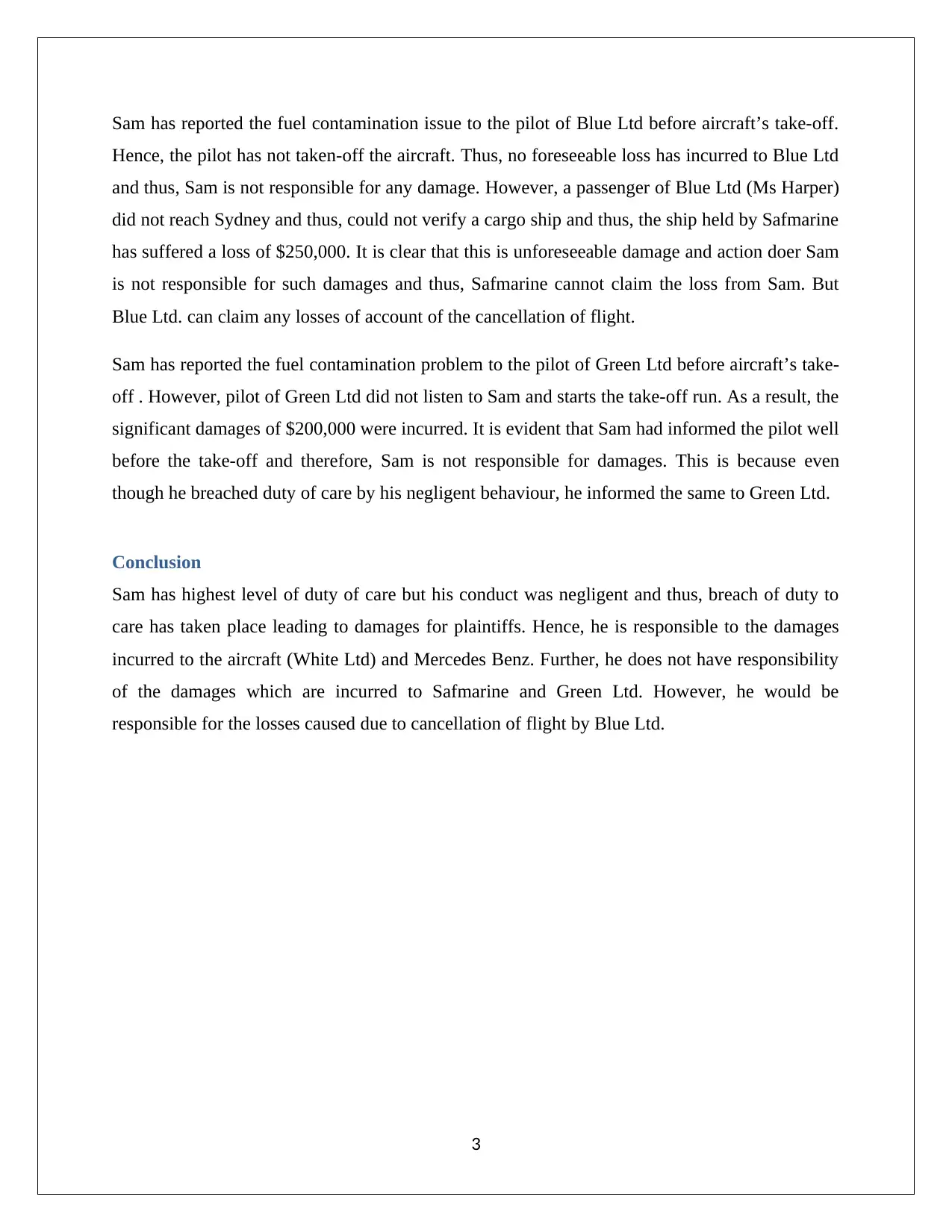
Sam has reported the fuel contamination issue to the pilot of Blue Ltd before aircraft’s take-off.
Hence, the pilot has not taken-off the aircraft. Thus, no foreseeable loss has incurred to Blue Ltd
and thus, Sam is not responsible for any damage. However, a passenger of Blue Ltd (Ms Harper)
did not reach Sydney and thus, could not verify a cargo ship and thus, the ship held by Safmarine
has suffered a loss of $250,000. It is clear that this is unforeseeable damage and action doer Sam
is not responsible for such damages and thus, Safmarine cannot claim the loss from Sam. But
Blue Ltd. can claim any losses of account of the cancellation of flight.
Sam has reported the fuel contamination problem to the pilot of Green Ltd before aircraft’s take-
off . However, pilot of Green Ltd did not listen to Sam and starts the take-off run. As a result, the
significant damages of $200,000 were incurred. It is evident that Sam had informed the pilot well
before the take-off and therefore, Sam is not responsible for damages. This is because even
though he breached duty of care by his negligent behaviour, he informed the same to Green Ltd.
Conclusion
Sam has highest level of duty of care but his conduct was negligent and thus, breach of duty to
care has taken place leading to damages for plaintiffs. Hence, he is responsible to the damages
incurred to the aircraft (White Ltd) and Mercedes Benz. Further, he does not have responsibility
of the damages which are incurred to Safmarine and Green Ltd. However, he would be
responsible for the losses caused due to cancellation of flight by Blue Ltd.
3
Hence, the pilot has not taken-off the aircraft. Thus, no foreseeable loss has incurred to Blue Ltd
and thus, Sam is not responsible for any damage. However, a passenger of Blue Ltd (Ms Harper)
did not reach Sydney and thus, could not verify a cargo ship and thus, the ship held by Safmarine
has suffered a loss of $250,000. It is clear that this is unforeseeable damage and action doer Sam
is not responsible for such damages and thus, Safmarine cannot claim the loss from Sam. But
Blue Ltd. can claim any losses of account of the cancellation of flight.
Sam has reported the fuel contamination problem to the pilot of Green Ltd before aircraft’s take-
off . However, pilot of Green Ltd did not listen to Sam and starts the take-off run. As a result, the
significant damages of $200,000 were incurred. It is evident that Sam had informed the pilot well
before the take-off and therefore, Sam is not responsible for damages. This is because even
though he breached duty of care by his negligent behaviour, he informed the same to Green Ltd.
Conclusion
Sam has highest level of duty of care but his conduct was negligent and thus, breach of duty to
care has taken place leading to damages for plaintiffs. Hence, he is responsible to the damages
incurred to the aircraft (White Ltd) and Mercedes Benz. Further, he does not have responsibility
of the damages which are incurred to Safmarine and Green Ltd. However, he would be
responsible for the losses caused due to cancellation of flight by Blue Ltd.
3
Paraphrase This Document
Need a fresh take? Get an instant paraphrase of this document with our AI Paraphraser
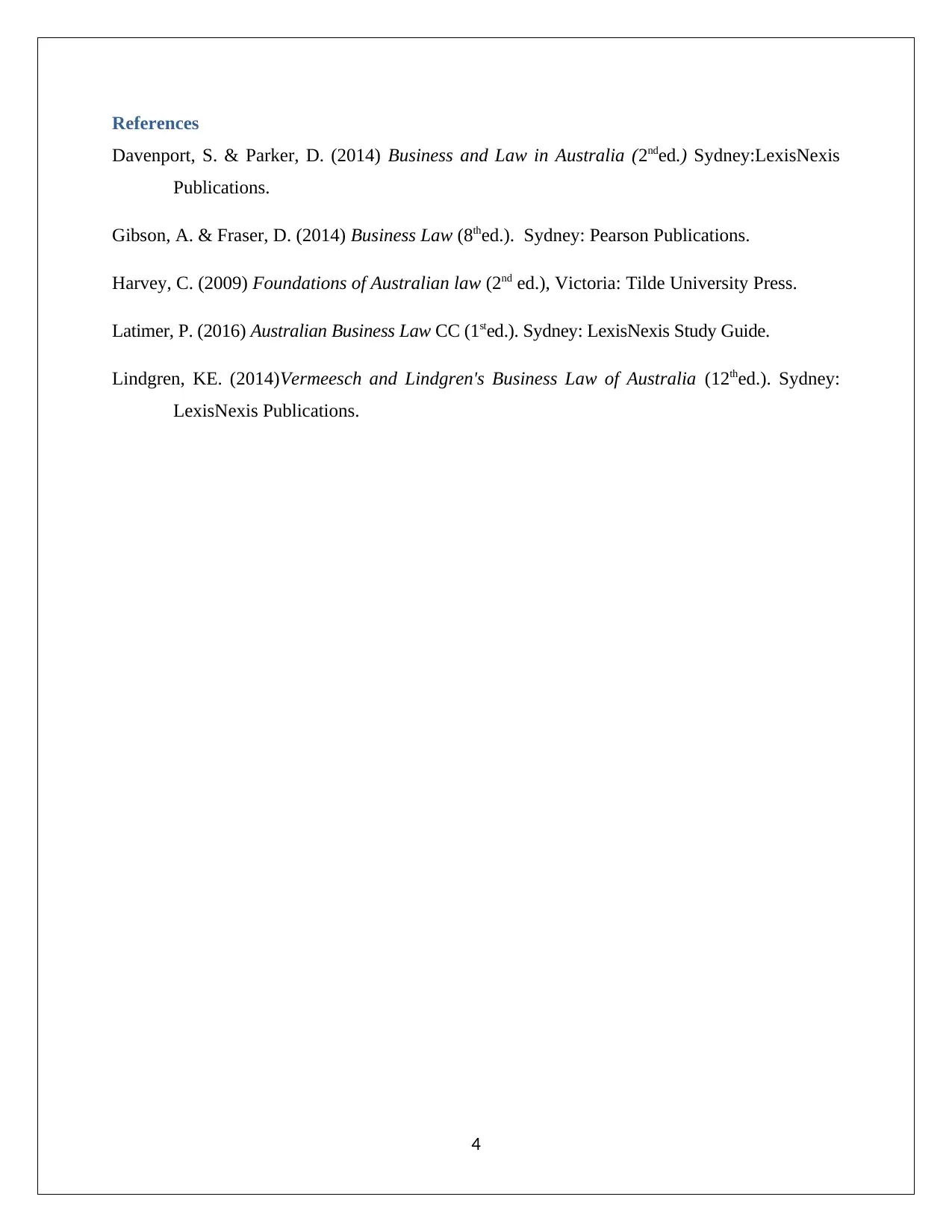
References
Davenport, S. & Parker, D. (2014) Business and Law in Australia (2nded.) Sydney:LexisNexis
Publications.
Gibson, A. & Fraser, D. (2014) Business Law (8thed.). Sydney: Pearson Publications.
Harvey, C. (2009) Foundations of Australian law (2nd ed.), Victoria: Tilde University Press.
Latimer, P. (2016) Australian Business Law CC (1sted.). Sydney: LexisNexis Study Guide.
Lindgren, KE. (2014)Vermeesch and Lindgren's Business Law of Australia (12thed.). Sydney:
LexisNexis Publications.
4
Davenport, S. & Parker, D. (2014) Business and Law in Australia (2nded.) Sydney:LexisNexis
Publications.
Gibson, A. & Fraser, D. (2014) Business Law (8thed.). Sydney: Pearson Publications.
Harvey, C. (2009) Foundations of Australian law (2nd ed.), Victoria: Tilde University Press.
Latimer, P. (2016) Australian Business Law CC (1sted.). Sydney: LexisNexis Study Guide.
Lindgren, KE. (2014)Vermeesch and Lindgren's Business Law of Australia (12thed.). Sydney:
LexisNexis Publications.
4
1 out of 5
Related Documents
Your All-in-One AI-Powered Toolkit for Academic Success.
+13062052269
info@desklib.com
Available 24*7 on WhatsApp / Email
![[object Object]](/_next/static/media/star-bottom.7253800d.svg)
Unlock your academic potential
© 2024 | Zucol Services PVT LTD | All rights reserved.





